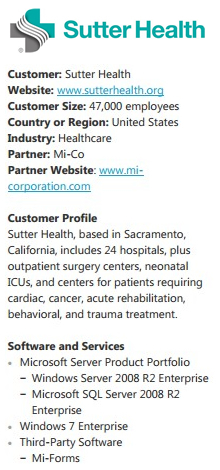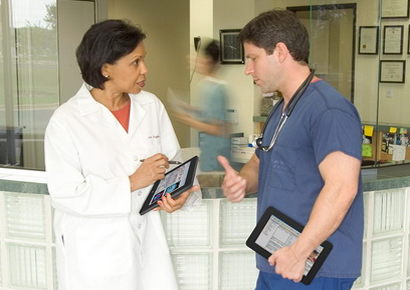Clipboards and pens were once a common data collection tool for hospitals, but now they are increasingly insufficient to meet the fast-growing data needs of accrediting bodies, payers, government agencies, and the hospitals themselves. Hospitals are increasingly trying user-friendly mobile forms and tablets to speed up mobile data collection for EMRs and other systems.
 A pioneer in this area is Sacramento-based Sutter Health, a network of doctors and hospitals that serves more than 100 cities throughout Northern California. Sutter Health now uses “Mi-Forms” mobile e-forms technology running on Windows tablets to capture data on patients and procedures. Data collection is 36 percent faster and is used to improve treatments, saving lives.
A pioneer in this area is Sacramento-based Sutter Health, a network of doctors and hospitals that serves more than 100 cities throughout Northern California. Sutter Health now uses “Mi-Forms” mobile e-forms technology running on Windows tablets to capture data on patients and procedures. Data collection is 36 percent faster and is used to improve treatments, saving lives.
Before moving to the mobile data collection solution, Sutter Health staff used electronic forms from national registries that were downloaded, printed, attached to clipboards. Employees re-keyed the data into databases or websites for validation which, ironically, could introduce errors.
Capturing the data at the point of care would have increased accuracy and timeliness, making the data more useful for analysis and improvements in care, but too often was impractical under treatment conditions.
Sutter first tried handheld mobile devices for mobile data capture, but the screens were too small for the amounts of data involved. And Android tablets and iPads lacked input mechanisms that were as fast and familiar as pen and paper, limiting their adoption at Sutter Health, especially by clinicians averse to extensive data collection.
Sutter’s Mobile Data Collection Solution
Sutter continued its search for better data collection until it found MiForms, a mobile enterprise application platform from Mi-Co, a member of the Microsoft Partner Network with Gold ISV competency. Sutter runs the Mi-Forms software on Windows 7 slates (tablets running the Windows 7 operating system) from Motion Computing, and supports it on the back end with applications built on Microsoft SQL Server 2008 R2 database management software running on the Windows Server 2008 R2 operating system.
“We built Mi-Forms on Windows in part because the ink capture is so refined,” says Gautham Pandiyan, Director of Sales & Marketing at Mi-Co. “For intensive data collection needs, especially away from a desktop PC, handwriting and ink capture are the way to go.”
Leaders at Sutter agreed. “We wanted an ink-capture solution, and that meant using Microsoft technology,” says Kyle Smith, Director of Clinical Data Integration at Sutter Health. “Because Microsoft is one of our corporate standards, it was easy and cost-effective to add Mi-Forms to our infrastructure.”
 Smith and his colleagues use Mi-Forms to design forms that look exactly like their paper counterparts—until data collectors use them. Then, the intelligence that Sutter builds into the forms hides or displays entire sets or pages of questions based on the collector’s initial entries. Fields that need responses based on an answer to an earlier question are highlighted; those that become irrelevant are dimmed. Data collectors can move easily and rapidly through the forms using built-in navigation.
Smith and his colleagues use Mi-Forms to design forms that look exactly like their paper counterparts—until data collectors use them. Then, the intelligence that Sutter builds into the forms hides or displays entire sets or pages of questions based on the collector’s initial entries. Fields that need responses based on an answer to an earlier question are highlighted; those that become irrelevant are dimmed. Data collectors can move easily and rapidly through the forms using built-in navigation.
“It’s like zapping your paper form right into the database,” says Dr. Richard Shaw, who is the Director of Clinical Informatics and Reporting, as well as Research Director, Division of Cardiology, at Sutter Health’s California Pacific Medical Center.
Sutter uses a SQL Server database as a back-end repository to store the clinical data that is captured as the clinician is on the move. SQL Server provides further data validation tools that help to ensure 100 percent data accuracy, and the SQL Server Reporting Services technology that runs key performance indicators and delivers data tailored to the user’s role and permissions.
Sutter applied the Mi-Forms solution to specific data collection needs: heart failure patient care risk assessments, rapid analysis of cardiac surgery metrics, realtime stroke patient data collection, and mobile data collection for accreditation organizations and national registries.
Mobile Data Collection Solution Benefits
Sutter Health uses Mi-Forms on Windows 7 slates to make mobile data collection and analysis faster and more accurate.
Success Spurred by Familiar Forms & Input
The solution is likely to be a success not only at Sutter Health but also elsewhere in the healthcare environment, according to Shaw. “Combine the feel of the paper-and pen approach with sophisticated and immediate feedback for data accuracy, and you have a compelling solution to the problem of intensive mobile data collection,” he says.
Data Input Time Reduced by 36 Percent
Patients with acute coronary syndrome (ACS) need care that gives them the best treatment in the timeliest manner. It takes a lot of data to tune an ACS program so that patients are diagnosed and treated quickly.
Shaw and his colleagues conducted a pilot test to see if clinical data collectors could gather ACS patient data with the same level of accuracy that they could using a standard database or web-based application. The results showed that, using Windows 7 slates and Mi-Forms, they completed the data collection process with greater accuracy, and 36 percent, 19 minutes, faster.
“The people you are asking to collect this data are highly trained and often are running a variety of disease management programs simultaneously,” says Shaw. “The time saved really counts in giving them rapid feedback on the quality of care.”
Data Extraction Time Reduced from Weeks to Minutes
Cardiac surgeons at Sutter Health review performance metrics in search of quality improvements every week—but, prior to the tablet PC solution, the data they used and extracted from paper files was often five to seven weeks old. Using the Windows 7 slates and Mi-Forms solution, the time for data extraction was reduced to 26 minutes.
“Now, you can have data from last week at the quality meetings, as opposed to the last quarter,” says Smith.
For more information on Mi-Forms mobile data collection, visit Mi-Corporation.com, or check out Mi-Co’s product summary page on MobileVillage.




